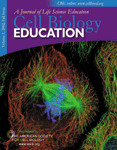WWW.Cell Biology Education
Cell Biology Education calls attention each quarter to several web sites of educational interest to the cell biology community. The Journal does not endorse or guarantee the accuracy of the information at any of the listed sites. If you want to comment on the selections or suggest future inclusions, please send a message to [email protected]. The sites listed below were last accessed on May 16, 2002.
THE WWW VIRTUAL LIBRARY: CELL BIOLOGY
http://vlib.org/Science/CellBiology/
This ambitious site claims to be “A guide to cell biology on the Web,” and it is. The site is maintained by Gabriel Fenteany of the Department of Chemistry at the University of Illinois at Chicago. It is part of the larger Virtual Library project overseen by Gerard Manning and started in 1993 by Tim Berners-Lee of the European Organization for Nuclear Research (CERN).
The initial page is divided into three areas: subject pages, related sections, and broad resources. Among the subject pages, General Cell Biology begins the section with a wide variety of topics including links to discussion groups such as Arabidopsis, Caenorhabditis elegans, Drosophila, protista, and urodeles. Twelve specialty topics are listed, ranging from angiogenesis to signal transduction. Under Angiogenesis, one of the links is to continuous and discontinuous modeling of the angiogenic process. This site would be helpful for introducing an interesting mathematical construct into a developmental biology class. The Signal Transduction link is rich with ideas to support teaching and giving students entrées for library research projects.
The material included in the broad resource area of the home page is striking. Some teachers of cell biology are far removed from current research literature. This uniform resource locator (URL) provides direct links to 350 cell biology research labs from around the world. Student and teacher alike could quickly identify who is doing what in cell biology by visiting this section of the site. It is unusually rich with links to cytoskeleton, cell motility, and motors research labs. The site is further enriched with extensive lists of DNA and protein databases, protocols, vendors, and cell biology journals. This metasite has something for everyone. Every cell biology instructor should bookmark this URL.
A WEB ATLAS OF CELLULAR STRUCTURES
http://www.itg.uiuc.edu/technology/atlas/
High school biology teachers often ask college biology instructors where to find some contemporary microscope images. This URL, located at the University of Illinois at Champaign-Urbana, has some extraordinary microscopy images of CV1 monkey kidney cells. The site is specifically designed for educators who are looking for such micrographs. The Imaging Technology Group (ITG) is a part of the Beckman Institute, and its home page provides access to a wide variety of digital-imaging subjects. In addition to the Web Atlas, there are Bugscope, Chickscope, and Visualization. S. Konda, S. Rogers, and D. Weber not only have put together an interesting collection of images but also provide descriptions of how the materials were prepared and how the microscopes were used to generate the images.
The page titled “Cellular Structures,” obtained through the Structures link of the Atlas, reveals six pictorial paths that may be followed: nucleus and microtubules, actin and microtubules, nucleus and actin, endoplasmic reticulum, the Golgi apparatus, and stages of mitosis. Each path leads to multiple images of cells, some at 24-bit resolution. The high-resolution pictures are large and a modem is inefficient at downloading the files. The Microscopy link has several pages explaining the difference between wide-field fluorescence microscopy and laser scanning confocal microscopy. There is also a comparison of regular bright-field microscopy, phase-contrast microscopy, and differential interference contrast microscopy. The site can enrich any presentation of cell organelles and the microscopy needed to produce the images.
MUSEUMS ONLINE
http://www.museumstuff.com/
Roy Hemmat initiated MuseumStuff.com in 1999. Its goal is “to help the public interact in meaningful ways with museums in the digital age, and expand the potential for museums to serve as educational instruments for the public.” The home page provides three topic areas: art, history, and science. Selecting “More Science” provides a grouping of 36 subtopics, including biology, biotechnology, cloning, and genetics. One of the better choices under Biology is www.BioInteractive.org. This link leads to the Howard Hughes Medical Institute virtual-reality exhibit. The exhibit includes a section on interactive labs with excellent demonstrations of enzyme-linked immunosorbent assay (ELISA) of three blood samples, a diagnostic cardiology lab, and an electrophysiology lab based on the leech. These interactive exhibits are engaging and have exceptional classroom potential. Currently MuseumStuff.com provides 539 links to science-based digital exhibits with about 90 specific to biological topics. Many hours could be spent searching through the various exhibits and databases. There are also links to museum shops, and a section for professional societies and organizations is useful. The site has many applications that extend beyond the museum orientation.



